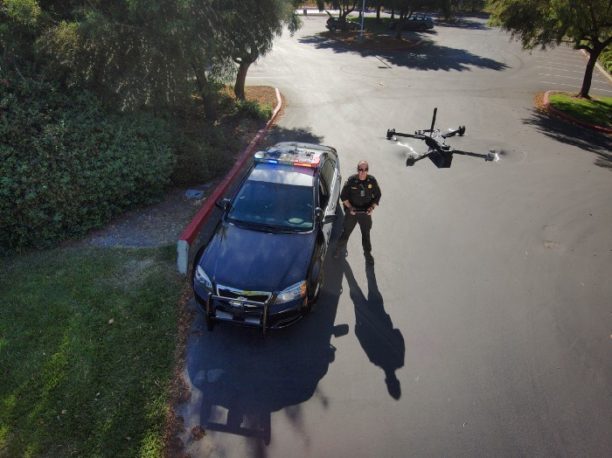At the Drone Thought Leadership Summit, hosted by the University of Virginia’s School of Continuing and Professional Studies Center for Public Safety and Justice in collaboration with DRONERESPONDERS, a panel of public safety leaders shared how drones are reshaping emergency response. Moderated by Ben Haiman, Executive Director of Public Safety and Justice at the University of Virginia, the discussion featured Deputy Chief of Operations Scott Carpenter of Charlottesville Fire, Deputy Chief Michael Lighthiser of George Mason University Police Department, DJ Smith of the Virginia State Police, Captain John English of Chula Vista Police Department, and Chief Charles Werner (Ret.), Director of DRONERESPONDERS.
A Game Changer in the Field
Panelists emphasized that drones are no longer experimental—they are game changers in search and rescue, tactical operations, and everyday response. “From a vertical view, drones give us overwatch and assessment that we simply didn’t have before,” said Deputy Chief Carpenter. He explained how aerial perspective allows fire crews to size up a scene in seconds, helping them deploy resources more effectively.
For police agencies, drones bring live, real-time data directly to command staff and officers in the field. “It’s the single greatest piece of integrated technology that I’ve used—the impact is massive,” said Captain English, describing Chula Vista’s Drone as First Responder (DFR) program – the first of its kind in the US. With drones arriving on scene in as little as 90 seconds, officers know what they are walking into before they arrive.
This situational awareness avoids surprises and allows agencies to “right size” their response—sending only the resources that are needed. The result is safer officers, fewer unnecessary deployments, and more informed decision-making.
DJ Smith underscored how this capability enhances both efficiency and safety in specialized missions. “Whether it’s search and recovery or tactical operations—live action intel makes you better at what you do,” he said. By streaming video to command centers in real time, drones give agencies the ability to adapt instantly as conditions change.
Protecting Officers, Suspects and Communities: De-escalation
Perhaps the most striking benefit for communities is the role drones play in incident de-escalation. Because officers can understand a situation in detail before approaching, they are better equipped to use measured, informed tactics. “It’s a huge de-escalation tool,” explained English. Instead of entering a situation blind, officers can see whether a suspect is armed, whether bystanders are nearby, or whether backup is truly necessary. This protects officers from unnecessary risk, but it also protects community members and suspects by reducing the chance of force being used in uncertainty.
Barriers to Broader Adoption
Despite their promise, drone programs face real hurdles. State-level restrictions and FAA regulations continue to limit certain operations. “As the technology evolves, we need to try and push the regulations as well,” said Deputy Chief Lighthiser. For state police, covering wide areas with DFR is not realistic, making tactical deployments their focus. Smith pointed to airspace management as an ongoing challenge: “We have one air boss, but we need to get better at knowing what’s in the air.”
Budgets and staffing are also persistent barriers. “The vast majority of agencies are operating with under $10,000 in budget,” said Chief Werner, stressing the need for careful planning and resource-sharing across fire and police. Carpenter added, “We started with training some pilots and then did some demonstration flights to show people what we could do.” English described Chula Vista’s incremental approach as “crawl, walk, run,” highlighting how building internal support and credibility was as important as flying missions.
Building Trust Through Transparency
Every panelist agreed that transparency is key to earning community trust. “Community engagement needs to start before you start your program—go to the schools, go to the town, educate your elected and appointed officials,” said Werner. Smith added, “Everyone has questions about drones. Talk about why you use them, what you are doing, and what you are not doing—we don’t have time to fly over your house 24 hours a day.”
Lighthiser noted that agencies must also be able to show how their programs are governed: “We have software that keeps track of everything we’re doing, flight records, where our sensor was looking—there are a lot of guardrails in place.” In addition to the drone specific systems in place, Lighthiser pointed out that police are already highly regulated – and those federal and state regulations apply to what agencies can do with drones.
When it comes to police drones, English put it simply: “If you don’t tell your story, somebody else will.”
The panel’s message was clear: despite occasional negative press or misconceptions, drones are proving to be invaluable for public safety and the communities they serve. They deliver faster response times, enhance safety, protect both officers and suspects, and optimize the use of city resources. The technology’s value lies not only in what it can do, but in how agencies communicate its role. Building trust requires constant outreach, transparency, and clarity—explaining both what drones are doing and what they are not.
Read more:


Miriam McNabb is the Editor-in-Chief of DRONELIFE and CEO of JobForDrones, a professional drone services marketplace, and a fascinated observer of the emerging drone industry and the regulatory environment for drones. Miriam has penned over 3,000 articles focused on the commercial drone space and is an international speaker and recognized figure in the industry. Miriam has a degree from the University of Chicago and over 20 years of experience in high tech sales and marketing for new technologies.
For drone industry consulting or writing, Email Miriam.
TWITTER:@spaldingbarker
Subscribe to DroneLife here.


